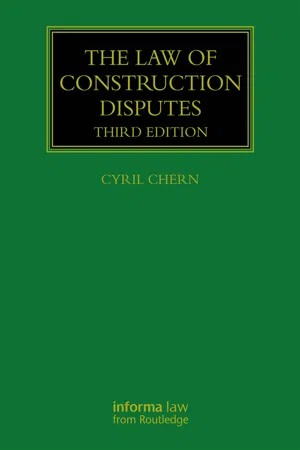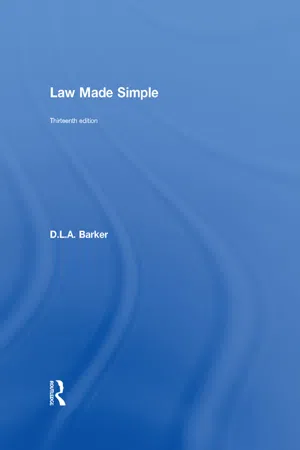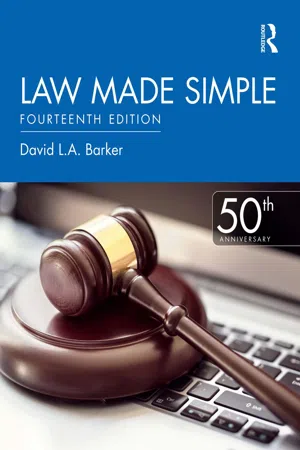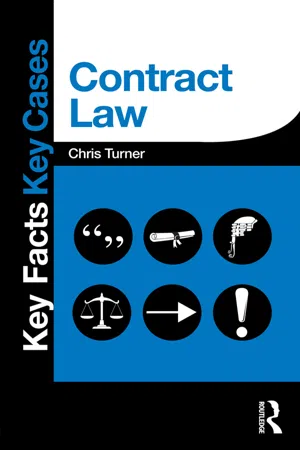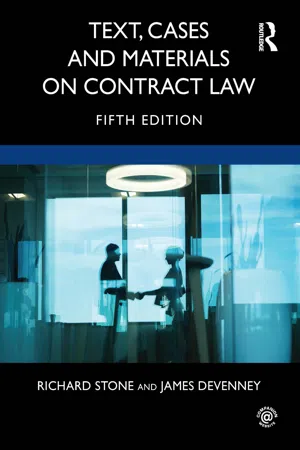Law
Formation of Contract
The formation of a contract refers to the process by which a legally binding agreement is created between two or more parties. It typically involves an offer, acceptance, consideration, and an intention to create legal relations. The key elements of a contract formation are essential for determining the validity and enforceability of the agreement.
Written by Perlego with AI-assistance
Related key terms
Related key terms
1 of 4
Related key terms
1 of 3
12 Key excerpts on "Formation of Contract"
- eBook - ePub
- Matt Hannaford, Paul Turner, Iain Goldrein(Authors)
- 2013(Publication Date)
- Informa Law from Routledge(Publisher)
CHAPTER 4CONTRACT FORMATION
4.1 INTRODUCTION
The aim of this chapter is to outline some of the key considerations that parties should keep in mind when entering into discussions which may (or may not) culminate in a legally binding contract for the sale and purchase of a ship.4.2 Formation of Contract
In most cases the three basic requirements for a valid contract under English law will be:4.2.1 Introduction- an intention to create a legally binding relationship;
- a concluded agreement on the essential terms of the contract; and
- consideration.
First, the parties must intend to create a legally binding relationship. In the case of commercial transactions there is a strong presumption that the parties intend their relationship to be legally binding, and will consider it so, given that the negotiations have been successfully concluded.1 Although this presumption may be rebutted by evidence to the contrary,2 the burden of proving that there was no such intention is a heavy one.3 In this situation, arbitral tribunals and the courts will try to determine the parties' objective intentions by reference to what they said and did during the negotiations.Second, there must be a concluded agreement on the essential terms of the contract. This will usually involve two pivotal elements — offer and acceptance — and in relation to these, the following basic rules typically apply.There must be an offer by one person (the “offeror”) that he is willing to contract on specific terms with the recipient of the offer (the “offeree”). The offer must set out the terms on which the offeror is willing to contract. It may also indicate the manner in which and the time within which the offer may be accepted. An offer must be sufficiently clear and detailed to be capable of acceptance. Arbitral tribunals and courts will generally apply an objective test to ascertain whether or not an offer has been made. - eBook - ePub
- Chris Turner(Author)
- 2014(Publication Date)
- Routledge(Publisher)
2 Formation of a contract: Offer and acceptance AIMS AND OBJECTIVES After reading this chapter you should be able to:Understand the essential requirements for valid formation of a contractUnderstand the basic character of an offerDistinguish between an offer and an invitation to treatUnderstand the need for communicationUnderstand how offers can be withdrawn and in what circumstancesUnderstand how an offer can be terminatedUnderstand the basic character of acceptanceDistinguish between a counter-offer and a mere enquiryUnderstand the significance of different methods of communicationUnderstand the circumstances in which unilateral contracts are madeCritically analyse the areaApply the law to factual situations and reach conclusions2.1 Formation of Contracts and the concept of agreementWe know from our introduction to the law of contract that the law concerns ‘bargains’ that are made between parties. The major significance of the word ‘bargain’ is that it involves an agreement that is binding on both parties. In contract law, then, it is insufficient merely that an agreement exists between two parties but rather that it involves that specific type of agreement which is enforceable by both parties in a court of law.A contract is completed when both sides honour an agreement by carrying out their particular side of the bargain. It is a breach of contract when a party fails to do so.However, because of the special nature of contractual agreements, we cannot identify a breach of contract where we may feel that we have not got what we paid for or ‘bargained’ for, without first showing that the agreement was indeed a contract.So the first thing that may need to be determined in any contract case is that there is proof that a contract actually exists, as opposed to some less formal, and thus unenforceable, arrangement between the parties. It is possible to tell if the arrangement is a contract because to be so it must have been formed according to certain standard rules. These are the rules of Formation of Contract - eBook - ePub
- Cyril Chern(Author)
- 2019(Publication Date)
- Informa Law from Routledge(Publisher)
CHAPTER 2The construction contract
Formation
All construction work is based upon contract, whether it be oral or in writing, but the first question to ask is whether there is in fact a contract at all. A building contract should define the relationship between the parties so that each knows what is going to be built, how long it should take and how much it is going to cost. In simple terms a contract is an exchange of promises, the breach of which results in a remedy at law. Thus, the essence of a building contract, like any other contract, is agreement. There has to be a point at which the parties are ad idem , i.e. of the same mind, as regards the terms of the contract they wish to agree and generally the contract will be formed when the parties reach that point.Defining a contract
While this book deals with those situations arising in construction contracts which give rise to a remedy at law, it is essential that a review of the fundamentals of the law of contracts be completed first. The words “contract” and “agreement” are synonymous and it is in the word “agreement” that the true nature of contracts arises. “Has there been an agreement?” is the essence of all contract disputes because without the parties’ agreeing on what has to be done and for what price (consideration) there can be nothing to enforce, i.e. there can be no remedy at law. Building contracts do not enjoy any special status and the fundamental requirements for contract formation established by the common law apply to all contracts. Thus, any contract is considered as formed if there has been a proper offer, which was validly accepted and the contracting parties have legal capacity to enter into a contract, as well as having the requisite intention to enter into the contract. Once this is established it will be necessary to determine whether the contract is supported by consideration and, in certain limited circumstances, whether the contract is in writing. Finally, the issue arises as to whether the contract is for an illegal or legal purpose.1 - eBook - ePub
- Kenny Chin(Author)
- 2014(Publication Date)
- Routledge-Cavendish(Publisher)
Contract law is categorised in the law of obligation. A contract creates a legal obligation between the contracting parties. When one party has not fulfilled, or is not going to fulfil the obligation, he can be sued for breach of contract. The court will help the innocent party by either ordering damages suffered to be compensated, compelling the party in breach to perform the contract (specific performance order) or prohibiting the wrongdoer to act in a way which would cause further breaches (injunction order). It is therefore important to know how and when a binding agreement has been created. The following are six main essentials for a contract to be formed, they are:- offer and acceptance;
- consideration;
- intention to create legal relationship;
- capacity;
- legality;
- consensus ad idem (meeting of minds).
For a contract to exist, the first three essentials have to be present. Without any of them, no contract has been formed in the first place. It is quite different when any of the latter three essentials is absent. If a party who lacks legal capacity, for example, a minor, makes a contract, the law recognises the contract, but may also intervene by giving the minor the option to avoid the contract. Therefore, the contract is not void, but is said to be voidable. If a contract is made with an illegal objective, the court will not enforce the contract, in other words, there is a contract, but it is unenforceable. When a person enters into a contract caused by fraud, misrepresentation, a serious mistake, duress or undue influence, there is, in effect, no meeting of minds. In some cases, the contracts are void and in others they may be voidable.OfferSir Guenter Treitel in his book, The Law of Contract, defines an offer as an expression of willingness to contract on certain terms made with the intention that it shall become binding as soon as it is accepted by the person to whom it is addressed.There are further rules, mostly created by common law, relating to ‘offer’. These are: Offer must be communicated to the offereeAn offer is an expression of willingness to contract and it must be expressed or communicated to a person, otherwise the person cannot accept something he is unaware of. For example, a reward has been offered for returning a lost item. If a person returns the item and, at the time, he does not know of the offer, then the offeror is not liable to reward him because he has not accepted anything and, therefore, there was no contract binding the parties. - eBook - ePub
Comparative Contract Law
An Introduction
- Ermanno Calzolaio(Author)
- 2022(Publication Date)
- Routledge(Publisher)
4 The Formation of Contracts
DOI: 10.4324/9781003251606-4The general rule is that the Formation of Contract takes place through an offer accepted by the other party. The meeting of the two constitutes the agreement. Put in this way, the rule seems very simple. However, significant differences in the mechanism of Formation of Contract derive from the different conceptions of contract highlighted in the previous chapter. Very briefly, in the civil law tradition the scheme of offer and acceptance is seen as the way through which the parties express their will. Consequently, acceptance is the manifestation of the intention to agree to the offer, giving rise to the conclusion of contract. From the common law perspective, the idea that reliance of the other party is relevant in order to create a binding obligation leads to shaping a clear distinction between an invitation to treat and an offer. Moreover, as acceptance essentially coincides with the consideration for the enforceability of the promise, an ‘objective’ approach is adopted in order to ascertain an offer and an acceptance.4.1 Offer and invitation to treat: a controversial distinction
The offer/acceptance scheme is criticized for many reasons. The most relevant one is that it is purported to be generally applicable, whereas contracts are made in different ways: in writing, orally, after long negotiations or instantaneously, by conduct of the parties, etc. It is almost impossible to frame rules that can be applied across such a broad spectrum. We will consider a critical situation which is useful to show a relevant difference between the civil law and the common law approaches. Does the display of goods amount to an offer? The answer followed in most civil law countries is affirmative if the necessary elements to form a contract (essentially the price) are clear. Instead, English law clearly distinguishes between offer and invitation to treat. - eBook - ePub
- David Barker(Author)
- 2014(Publication Date)
- Routledge(Publisher)
Chapter 7The law of contract
Key points
• what constitutes a contract• the essentials of a valid contract• void, voidable and illegal contract• the ways in which a contract may be discharged• remedies for breach of contractIn his book Principles of the Law of Contracts , Sir William Anson defined a contract as a legally binding agreement made between two or more parties, by which rights are acquired by one or more to acts or forbearances on the part of the other or others . Shortly it may be defined as an agreement between two or more parties that is intended to have legally enforceable consequences.The agreement referred to in the definition means a meeting of minds, called in law consensus ad idem , signifying that the parties are agreed together about the same thing. The definition also emphasizes that the parties to the contract must intend that their agreement shall be legally enforceable. Unless the law recognizes this and enforces the agreements of parties, it would be impossible to carry on commercial or business life. For this reason the law of contract plays a leading role in courses on business studies.These contractual agreements give rise to rights and obligations that the law recognizes and enforces. But certain agreements, such as domestic and social arrangements, are not intended by the parties to be legally binding. The law allows for this. Suppose, if Cumming and Gowing agree to meet for dinner and Gowing fails to turn up, the law will do nothing in the matter. The agreement was not intended to create legal rights and duties, and, as such, it is not a contract in law. Every contract is an agreement, but not every agreement is a contract.The object of the law of contract is to identify those agreements that it will enforce and those that it will not. This is of prime importance and will be referred to later in more detail. - eBook - ePub
- Jennifer Corrin-Care(Author)
- 2015(Publication Date)
- Routledge-Cavendish(Publisher)
CHAPTER 2 FORMATION OF AN AGREEMENT INTRODUCTION This chapter examines the elements necessary for a binding agreement to arise. The courts have developed rules to assist in determining this. These rules are very useful when trying to analyse facts. However, it should always be borne in mind that the rules are only tools to be used in trying to identify the essence of a contract. Some lawyers consider that the rules are too restrictive and that it is more important to look at the circumstances as a whole to see whether there is a contract, rather than to analyse the facts to establish separate legal elements of an agreement. 1 The artificiality which may result from adherence to the rules in complex cases was pointed out in New Zealand Shipping Co Ltd υ AM Satterthwaite & Co Ltd, 2 where Lord Wilberforce said: English Law, having committed itself to a rather technical and schematic doctrine of contract, in application takes a practical approach, often at the cost of forcing the facts to fit uneasily into the marked slots of offer, acceptance, and consideration. There may be cases where the courts are prepared to find that the essence of contract is present, even though it is difficult or impossible to analyse the transaction in terms of the rules discussed in this chapter. 3 Nevertheless, the rules are a useful starting point and regional courts expect counsels’ arguments, in disputes regarding the existence of an agreement, to be founded on the rules. 4 AGREEMENT The first essential element of a simple contract is an agreement. As discussed in Chapter 1, a contract is a legally binding agreement made between two or more people who intend it to have legal effect. There are therefore two elements: an agreement and legal enforceability. This chapter discusses the first element, but is should always be borne in mind that not all agreements are legally enforceable - eBook - ePub
- David L.A. Barker(Author)
- 2020(Publication Date)
- Routledge(Publisher)
Chapter 7The law of contract
Key points
- what constitutes a contract
- the essentials of a valid contract
- void, voidable and illegal contract
- the ways in which a contract may be discharged
- remedies for breach of contract
In his book Principles of the Law of Contracts , Sir William Anson defined a contract as a legally binding agreement made between two or more parties, by which rights are acquired by one or more to acts or forbearances on the part of the other or others . Shortly it may be defined as an agreement between two or more parties that is intended to have legally enforceable consequences.The agreement referred to in the definition means a meeting of minds, called in law consensus ad idem , signifying that the parties are agreed together about the same thing. The definition also emphasizes that the parties to the contract must intend that their agreement shall be legally enforceable. Unless the law recognizes this and enforces the agreements of parties, it would be impossible to carry on commercial or business life. For this reason the law of contract plays a leading role in courses on business studies.These contractual agreements give rise to rights and obligations that the law recognizes and enforces. But certain agreements, such as domestic and social arrangements, are not intended by the parties to be legally binding. The law allows for this. Suppose, if Cumming and Gowing agree to meet for dinner and Gowing fails to turn up, the law will do nothing in the matter. The agreement was not intended to create legal rights and duties, and, as such, it is not a contract in law. Every contract is an agreement, but not every agreement is a contract.The object of the law of contract is to identify those agreements that it will enforce and those that it will not. This is of prime importance and will be referred to later in more detail.An agreement will be enforced when the following essential elements exist:7.1 Essentials of a valid contract
- Offer and acceptance
- eBook - ePub
- Chris Turner(Author)
- 2013(Publication Date)
- Routledge(Publisher)
3Formation of a contract: consideration and intention3.1 The nature and purpose of consideration1Contract law concerns enforcement of promises based on mutual agreement. 2In the early forms of contract law (debt, detinue, covenant) proof that a binding agreement existed was easily found in the form of the agreement (i.e. was only binding if under seal). 3Enforcing informal agreements developed in the sixteenth century with the law of assumpsit: •the law would still not enforce merely gratuitous promises; •so the law had to develop an element that could distinguish between a proper contractual agreement that would be enforced, and something less that would not. 4This was the origin of the element of consideration: a)Proof was required that the party seeking to enforce the contract was in fact a party to a mutual agreement by contributing something in return for the promise of the other party. b)This was the quid pro quo – one thing in return for another.c)I n the sixteenth and seventeenth centuries, the courts asked for evidence of the existence of this extra element before they would acknowledge the existence of the agreement in law. d)Defining consideration was and remains a problem. 3.2 Defining consideration1Originally no single definition could be found. 2Often the view taken was that consideration was no more than the reason why the promise should be enforced in the case. 3It was first seen as a rule of evidence, and later as a moral obligation, neither of which makes consideration an essential in identifying a binding contract. 4Nineteenth-century judges saw the essential difference between speciality agreements and ‘parol’ agreements (Eastwood v Kenyon - No longer available |Learn more
- Richard Stone, James Devenney(Authors)
- 2022(Publication Date)
- Routledge(Publisher)
As we have seen, the process by which the courts try to decide whether the parties have made an agreement generally does not involve looking for actual (subjective) agreement but rather focuses on the external signs of agreement. The classical theory of contract relied on a number of specific elements, which were regarded as both necessary and sufficient to identify an agreement that is intended to be legally binding. These were:- offer;
- acceptance;
- consideration; and
- intention to create legal relations.
These four factors formed the classical basis for the identification of contracts in the law of England and Wales. As far as offer and acceptance are concerned, in the modern law the courts have, as will be noted below, at various times recognised the difficulty of analysing all contractual situations in terms of these concepts. Some attempts, with various degrees of success, have been made to apply a more general test of ‘agreement’. This involves taking offer and acceptance as the normal basis for the creation of a contract, but recognising that not all contracts will be made in this way.1616 This is similar to the approach taken in the European Draft Common Frame of Reference – see Book II, Chapter 4, and in particular paragraphs II. – 4:101 and II. – 4:211.The rest of this chapter explores the current approach in England and Wales to offer and acceptance in detail. Consideration is dealt with in Chapter 3 and intention to create legal relations in Chapter 4 .2.6 HISTORICAL BACKGROUND
The rules of ‘offer’ and ‘acceptance’, and their use as the basis for deciding whether there has been an agreement between contracting parties, derives, as with much of the classical law of contract, from late eighteenth- and early nineteenth-century case law.1717 See, in particular, Adams v Lindsell (1818) 1 B & Ald 681; 106 ER 250 – discussed in detail in 2.12.6.2.7 OFFER
An offer may be defined as a definite indication by one person that he or she is prepared to contract with one or more others on certain terms, which are fixed, or capable of being fixed, at the time the offer is made. Thus the statement ‘I will sell you 5,000 widgets for £1,000’ is an offer, as is the statement ‘I will buy from you 5,000 shares in X Ltd, at their closing price on the London Stock Exchange next Friday.’ In the former case the terms are fixed by the offer itself; in the latter, they are capable of becoming fixed on Friday, according to the price of the shares at the close of business on the Stock Exchange. The offer may be made by words, conduct or a mixture of the two. The concept applies most easily to a situation such as that given in the above example where there are two parties communicating with each other about a commercial transaction. It fits less easily, as will be seen below, in many other everyday transactions, such as supermarket sales or those involving the advertisement of goods in a newspaper or magazine. What the courts are looking for is some behaviour that indicates a willingness to contract on particular terms. Once there is such an indication, all that is then required from the other person is a simple assent to the terms suggested, and an agreement will be formed. The ‘indication of willingness’ referred to above may take a number of forms – for example, the spoken word, a letter, a fax message, an email or an advertisement on a website. As long as it communicates to the potential acceptor or acceptors the basis on which the offeror is prepared to contract, then that is enough. It is not necessary for the offer itself to set out all the terms of the contract. The parties may have been negotiating over a period of time, and the offer may simply refer to terms appearing in earlier communications. That is quite acceptable, provided that it is clear what the terms are. - eBook - ePub
- Richard Stone, James Devenney(Authors)
- 2022(Publication Date)
- Routledge(Publisher)
Chapter 2 Forming the agreement
Chapter contents 2.1 Introduction 2.2 Forming an agreement Additional reading2.1 Introduction
An agreement is central to the law of contract in England and Wales. In most cases that are adjudicated by the courts, the courts regard themselves as giving effect to an agreement reached between the parties. The question of whether or not there is a sufficient agreement is, therefore, a crucial one. The agreement must also be intended to be legally binding, and this aspect is considered in detail in Chapter 3 . The focus in this chapter is on the mechanisms that the courts use to decide whether an agreement has been reached. One issue relates to formalities (e.g. writing): to what extent does English law use formal mechanisms to decide whether an agreement has been reached? Sometimes statutes require formality in relation to a particular type of contract. In many cases, however, formality is not required and the law will look at more informal evidence of agreement. More specifically, courts decide whether an agreement has been reached by taking an ‘objective’ approach, looking at what the parties have said or done as indicators of their state of mind. The identification of a matching offer and acceptance is the most common way for the courts to find that an agreement has been made. An offer must be distinguished from an invitation to treat, and an acceptance from a counter-offer. The time and place of acceptance can cause particular problems when parties are contracting at a distance. Special rules apply to posted acceptances, as opposed to those communicated by telephone or electronically. The chapter concludes by considering the ways in which an offer is revoked, and when it will lapse if not accepted.2.2 Forming an agreement
There are a number of possibilities as to the way in which it could be decided if the parties have reached an agreement. The courts could look for formal signs (for example, a signed written document), or particular forms of words, or simply any extrinsic evidence of an intention to make an agreement – in a sense, a ‘meeting of the minds’. As will be seen, the law in England and Wales makes use of a variety of approaches. It is important to note from the outset, however, that formality is by no means an essential requirement for most contracts. Many everyday contracts – for example, purchases from a shop – are made purely orally and with no documentation in writing. It is possible for very large contracts, involving substantial sums of money, to be made in such an informal way, though in practice most large organisations will want to contract on the basis of terms that are set out in writing. It is only in a relatively small number of situations that the law of England and Wales actually imposes on the parties a requirement of formality, and will hold the agreement unenforceable unless it follows these requirements. - eBook - ePub
- Vai Io Lo, Xiaowen Tian(Authors)
- 2009(Publication Date)
- Routledge(Publisher)
Although contract laws differ from country to country, they have many similarities and cover a number of common issues, including formation, performance, breach, and remedies. Focusing on these common issues, this section is designed to help foreign investors understand the basic ingredients of Chinese contract law. To begin with, the Contract Law provides that a contract is an agreement by which civil rights and obligations are established, modified, or terminated between natural persons, legal persons, and other economic organizations that are subjects of equal status. Nevertheless, it is imperative to know that not all agreements are legally enforceable contracts. A legally enforceable contract must meet certain requirements prescribed by the Contract Law.Offer and acceptance
First of all, there must be an offer and an acceptance. An offer ( ) is the manifestation of the intention of one party (the offeror) to enter into a contract with another party (the offeree). The contents of the offer must be concrete and definite, and the offer must indicate that once the offeree accepts the offer, the offeror will be bound. In contrast, an invitation to offer ( ), which is generally referred to as an invitation to treat in common law countries, is the manifestation of one’s intention to be given an offer. Mailed price lists, auction announcements, bidding announcements, prospectuses, and commercial advertisements are only invitations to offer. Even so, if the contents of a commercial advertisement are in accord with the requirements of an offer, it will be deemed an offer.An offer becomes effective when it reaches the offeree. If a contract is to be concluded by means of data-telex ( ) and the recipient designates a specific system to receive the data-telex, the time at which the data-telex enters the designated system will be the time of arrival, but if no system is designated, the time at which the data-telex first enters any system of the recipient will be regarded as the time of arrival. Nonetheless, the offeror may withdraw ( ) an offer by sending a notice of withdrawal to the offeree. The notice of withdrawal must reach the offeree before or at the same time at which the offer reaches the offeree (that is, the offer has not yet become effective). Similarly, the offeror may revoke (
Index pages curate the most relevant extracts from our library of academic textbooks. They’ve been created using an in-house natural language model (NLM), each adding context and meaning to key research topics.
Explore more topic indexes
Explore more topic indexes
1 of 6
Explore more topic indexes
1 of 4


